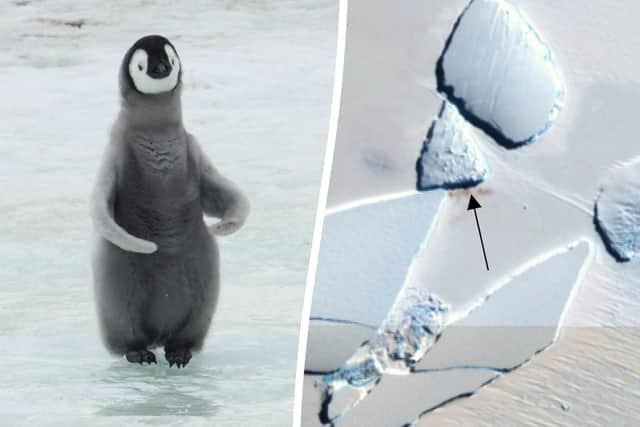Emperor penguins: Four new colonies discovered for species at risk of quasi-extinction this century
and live on Freeview channel 276
Four previously unknown colonies of emperor penguins have been discovered - but they may not be enough to turn the tide for the imperilled Antarctic icons.
Scientists from British Antarctic Survey (BAS) found the new breeding sites using satellite imagery, which picked up the dark brown guano stains they left behind against the stark white of the ice. The BAS had been trying to track other, known colonies when they discovered the new ones, as changing sea ice conditions along Antarctica's coastlines drove a number of groups to move as far as 40km inland - in search of more stable ice to raise their chicks on.
Advertisement
Hide AdAdvertisement
Hide AdOn top of the four new colonies, the Halley Bay colony - previously thought to have vanished - was re-discovered near the MacDonald Ice Rumples, 30km east of its old site. This brings the total of known emperor penguin colonies to 66.


This comes at a time when the future of the iconic species looked bleak. Last year, four out of five emperor penguin colonies in one Antarctic region suffered "catastrophic breeding failure" - where no chicks survived to adulthood - after breeding sites suffered a 100% loss of vital sea ice, well before the young chicks would have grown the waterproof feathers they needed to survive. Researchers predict that more than 90% of emperor penguin colonies will be quasi-extinct - or doomed to extinction even if some individuals are still alive - by the end of this century, based on current global warming trends.
Dr Peter Fretwell, who uses satellite imagery to monitor penguin populations at BAS, told SWNS that while the newly discovered breeding sites filled in a few gaps, they will likely not be enough to turn their fate around. "All except one of these colonies are small with less than 1000 birds, so finding these new colonies makes little difference to the overall population size. In fact, it is overshadowed by the recently reported breeding failures due to the early and fast ice loss."
Emperor penguins are dependent on stable sea ice that is firmly attached to the shore – known as ‘land-fast’ ice – for most of the year. Once they arrive at their chosen breeding site, the penguins lay eggs in the Antarctic winter from May to June. Their eggs hatch after 65 days, but chicks do not fledge until between December and January.
Advertisement
Hide AdAdvertisement
Hide AdSince 2016, Antarctic has experienced the four years with the lowest sea ice cover in scientists' 45-year satellite record - with the two lowest years in 2021/22 and 2022/23. As of August 2023, the sea ice covered 2.2 million-square kilometres less than the 1981 – 2022 average, an area larger than Greenland.
Last year was also the hottest ever recorded, with the highest average temperature worldwide. However, experts are already warning that 2024 might break that record.
Comment Guidelines
National World encourages reader discussion on our stories. User feedback, insights and back-and-forth exchanges add a rich layer of context to reporting. Please review our Community Guidelines before commenting.
